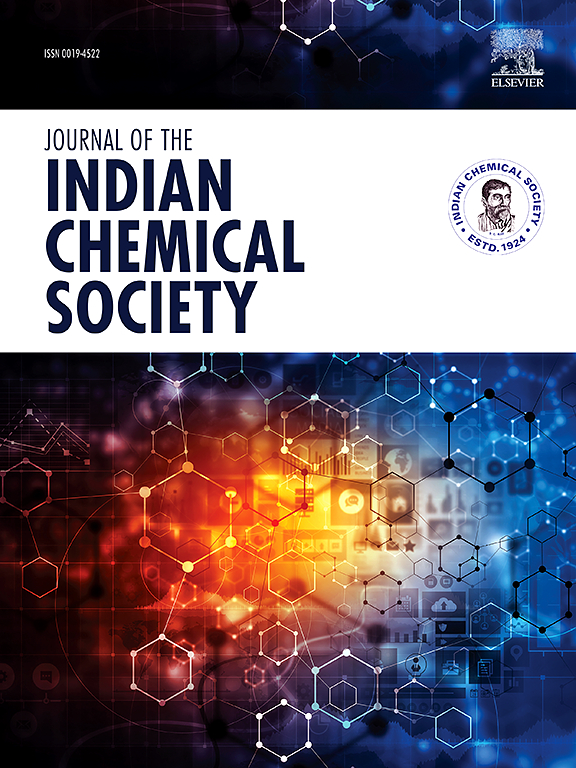Ni0.5Mg0.5RE0.03Fe1.97O4尖晶石铁素体中掺杂不同稀土元素的结构、磁性及Mössbauer研究
IF 3.2
4区 化学
Q2 CHEMISTRY, MULTIDISCIPLINARY
引用次数: 0
摘要
采用水热法制备了Ni0.5Mg0.5RE0.03Fe1.97O4 (RE = Ce3+, Dy3+, Gd3+, Pr3+, Sm3+)纳米铁素体。x射线衍射(XRD)和傅里叶变换红外光谱(FTIR)证实了尖晶石结构的形成。晶体尺寸在9.33 ~ 22.89 nm之间,晶格参数随掺杂剂离子半径的变化从8.285增大到8.462 Å。x射线密度在4.761 ~ 5.021 g/cm3之间。比表面积(SSA)在52.3 ~ 125.9 m2/g之间。A-和b -位点的跳长分别为3.588 ~ 3.664和2.929 ~ 2.991 Å。扫描电子显微镜(SEM)显示出物理形状和团聚的纳米颗粒。当测量温度从室温(300K)降低到4K时,矫顽力场的演变表明了阻滞磁矩的热不稳定性。较高的矫顽力使材料适合于变压器和高频器件的应用。场冷却(FC)和零场冷却(ZFC)表明,未掺杂样品(Ni0.5Mg0.5Fe2O4)的阻滞温度为29K, ce掺杂样品(Ni0.5Mg0.5Ce0.03Fe1.97O4)的阻滞温度为33K, sm掺杂样品(Ni0.5Mg0.5Sm0.03Fe1.97O4)的阻滞温度为13K。本文章由计算机程序翻译,如有差异,请以英文原文为准。

Investigations on structural, magnetic and Mössbauer studies of various rare-earths doped in Ni0.5Mg0.5RE0.03Fe1.97O4 spinel ferrite
Ni0.5Mg0.5RE0.03Fe1.97O4 (RE = Ce3+, Dy3+, Gd3+, Pr3+, and Sm3+) nanoferrites were synthesized using the hydrothermal method. The X-ray diffraction (XRD) and The Fourier transform infrared spectroscopy (FTIR) confirmed the formation spinel structure. The obtained crystallite sizes ranged between 9.33 and 22.89 nm, while lattice parameters increased from 8.285 to 8.462 Å depending on the ionic radii of dopants. X-ray densities ranged between 4.761 and 5.021 g/cm3. The specific surface area (SSA) ranged between 52.3 and 125.9 m2/g. Hopping lengths on A- and B-sites ranged between 3.588 and 3.664 and 2.929 and 2.991 Å, respectively. The scanning electron microscopy (SEM) revealed physically shaped and agglomerated nanoparticles. The evolution of coercive fields upon reducing the measuring temperature from room temperature (300K) to 4K indicates the thermal instability of the blocked magnetic moments. Relatively high coercive fields make the materials suitable for application in transformers and high-frequency devices. Field cooling (FC) and zero field cooling (ZFC) revealed the blocking temperatures to be 29K for the undoped sample (Ni0.5Mg0.5Fe2O4), 33K for Ce-doped (Ni0.5Mg0.5Ce0.03Fe1.97O4), and 13K for Sm-doped (Ni0.5Mg0.5Sm0.03Fe1.97O4) nanoferrites.
求助全文
通过发布文献求助,成功后即可免费获取论文全文。
去求助
来源期刊
CiteScore
3.50
自引率
7.70%
发文量
492
审稿时长
3-8 weeks
期刊介绍:
The Journal of the Indian Chemical Society publishes original, fundamental, theorical, experimental research work of highest quality in all areas of chemistry, biochemistry, medicinal chemistry, electrochemistry, agrochemistry, chemical engineering and technology, food chemistry, environmental chemistry, etc.

 求助内容:
求助内容: 应助结果提醒方式:
应助结果提醒方式:


